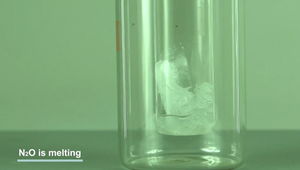Nitrous oxide
 Frozen nitrous oxide melting in a vial
| |
| Names | |
|---|---|
| IUPAC name
Dinitrogen monoxide
| |
| Other names
Dinitrogen monoxide
Dinitrogen oxide Hyponitrous oxide Laughing gas Protoxide of nitrogen Sweet air | |
| Properties | |
| N2O | |
| Molar mass | 44.013 g/mol |
| Appearance | Colorless gas |
| Odor | Slightly sweetish |
| Density | 1.266 g/L (-88.9 °C) 1.977 g/L (STP) |
| Melting point | −90.86 °C (−131.55 °F; 182.29 K) |
| Boiling point | −88.48 °C (−127.26 °F; 184.67 K) |
| 1.5 g/L (15 °C) | |
| Solubility | Soluble in alcohols, ethers, sulfuric acid |
| Vapor pressure | 4.29·104 mmHg at 25 °C |
| Thermochemistry | |
| Std molar
entropy (S |
219.96 J·K−1·mol−1 |
| Std enthalpy of
formation (ΔfH |
82.05 kJ/mol |
| Hazards | |
| Safety data sheet | Sigma-Aldrich |
| Flash point | Non-flammable |
| Related compounds | |
| Related compounds
|
Nitric oxide Nitrogen dioxide |
| Except where otherwise noted, data are given for materials in their standard state (at 25 °C [77 °F], 100 kPa). | |
| Infobox references | |
Nitrous oxide, also known as dinitrogen monoxide, nitrogen protoxide, nitrous, nitro, NOS or more popular laughing gas is a chemical compound with the formula N2O.
Contents
Properties
Chemical
Nitrous oxide is an oxidizer. Unlike other nitrogen oxides, nitrous oxide does not react with water to form nitric acids.
Physical
Nitrous oxide is a colorless, non-flammable gas, with a slightly sweet odor and taste. It is poorly soluble in water, but more soluble in several organic solvents such as ethanol, diethyl ether, as well as sulfuric acid. It is known as "laughing gas" due to the euphoric effects of inhaling it, a property that has led to its recreational use as a dissociative anaesthetic.
Availability
Nitrous oxide is available as whippets. Medical grade nitrous oxide tanks are available in dentistry, though they are not easy to acquire by the average person.
Preparation
Nitrous oxide is prepared by the careful decomposition of ammonium nitrate, which results in nitrous oxide and water vapor.
- NH4NO3 → N2O + 2 H2O
Due to the very low amount of secondary products, this reaction is preferred by many chemists, albeit molten ammonium nitrate can explode very easily, making this route dangerous.
A less dangerous route involves heating hydroxylammonium chloride with sodium nitrite yields nitrous oxide.[1]
- NH2OH·HCl + NaNO2 → N2O + NaCl + 2 H2O
Another way of preparing nitrous oxide involves heating a mixture of ammonium sulfate and sodium nitrate.
- 2 NaNO3 + (NH4)2SO4 → Na2SO4 + 2 N2O+ 4 H2O.
Another route involves heating a mixture of urea, nitric acid and sulfuric acid between 40-100°C and purifying N2O from resulting gaseous products:
- 2 (NH2)2CO + 2 HNO3 + H2SO4 → 2 N2O + 2 CO2 + (NH4)2SO4 + 2 H2O[2]
Projects
- Rockets
- Sodium azide synthesis
- Laughing gas (medical grade only!)
Handling
Safety
Nitrous oxide has low toxicity and posses analgesic properties. It can be very addictive and its misuse can have a moderate to serious psychological and nervous impact. Nitrogen protoxide is a strong oxidizer and should be kept away from any combustible materials.
When obtaining it from ammonium nitrate, it's imperative to prevent the temperature from rising too high, as it may cause an explosion if large quantities are used. This isn't an issue with commercial AN, as it contains gypsum which acts as a stabilizer and reduces the risk of explosion.
Storage
Nitrous oxide cylinders should be stored in cold places, away from any organic materials, as it is a strong oxidizer and a fire hazard.
Disposal
Nitrous oxide will eventually break down in air into nitrogen and oxygen, and does not generate any toxic byproducts. This reaction is sped up by reducing agents.
References
- ↑ https://www.youtube.com/watch?v=uzSe3BDCkF8
- ↑ https://erowid.org/archive/rhodium/chemistry/nitrous.html